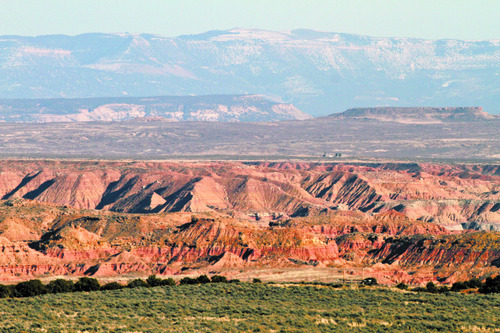This is an archived article that was published on sltrib.com in 2012, and information in the article may be outdated. It is provided only for personal research purposes and may not be reprinted.
A state panel gave a key approval Wednesday to start a tar sands mine in Utah's wild Book Cliffs in eastern Utah.
After hearing from the company behind the project, Alberta-based U.S. Oil Sands, as well as the group that appealed the initial project approval, Moab-based Living Rivers, board members voted 9-2 to uphold the state's previous OK of the project, the nation's first fuel producing tar-sands mine.
Rob Dubuc, Living Rivers attorney, said: "We're likely to appeal" in court.
Water Quality Division Director Walt Baker signed off on the proposal last year without requiring a groundwater-pollution permit. Basically, he concluded that there is no groundwater to pollute in the project site, around 213 acres in the arid high country between Vernal and Moab.
In August, Administrative Law Judge Sandra Allen agreed with Baker, and the water-quality board reviewed that conclusion on Wednesday. Darrell H. Mensel, representing recreation, and Merritt K. Frey, representing wildlife and the environment, both expressed concern about whether the permit met the strict definition of state law on groundwater, and they both voted against the administrative law judge's finding.
But other members agreed that Living Rivers had not offered proof that the project poses any threat to groundwater.
Paul McConkie, an assistant attorney general representing the water-quality division, said the judge's review had been painstaking and that the company would be required to begin monitoring if contamination was discovered in the future.
"If they ever do run into groundwater," he told the board, "they'll test it."
Meanwhile, Dubuc urged caution, given that the project is the first of its kind here. "What we're asking for is a more rigorous oversight of this mine."
Members of Utah Tar Sands Resistance attended the hearing. But, as members of the public, they were not permitted to provide input.
Raphael Cordray, a member of the group, vowed afterward to continue the fight. She said state surveys of the area show there are aquifers below the area that will be strip mined, and they should be protected.
"We knew this was going to happen," she said. "But we're ashamed they made such an absurd ruling."
Meanwhile, the company said it hopes to be mining around this time next year. Barclay E. Cuthbert, vice president of operations for U.S. Oil Sands, said his company hopes to finalize its Utah Division of Oil Gas and Mining permit in coming weeks.
That state permit application, originally submitted two years ago, also has been approved — and later appealed by Living Rivers. The mining board was waiting to see the water-quality board's decision.
"Our board," said division director John Baza, "basically has the same decision to make."
Twitter: @judyfutah Panel beefs up Utah fracking rules
The Utah Board of Oil Gas and Mining has added a provision to regulations on hydraulic fracturing that would require companies to begin reporting the chemicals they inject in the ground to extract natural gas.
"We realize we need more clarity from the industry," said John Baza, director of the Utah Division of Oil Gas and Mining.
Laurel Hagen, executive director of the Utah Watersheds Council, noted that 14 states have a similar disclosure rule. She was concerned that environmental groups didn't know the regulations were up for review, and that they would have liked to join the discussion. "It's a step in the right direction. But we need to take a lot more steps to make [the regulation] effective."
The new reporting requirement is effective Nov. 1. After that, companies will have to report the chemicals they used within 60 days.
Judy Fahys



